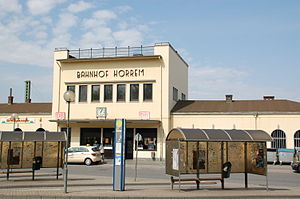Horrem station
| Through station | |
 |
|
| Location | Bahnhofstr. 9, Horrem, North Rhine-Westphalia Germany |
| Coordinates | 50°54′59″N 6°42′53″E / 50.916492°N 6.714768°ECoordinates: 50°54′59″N 6°42′53″E / 50.916492°N 6.714768°E |
| Line(s) | |
| Other information | |
| Station code | 2919 |
| DS100 code | KHR |
| IBNR | 8000178 |
| Category | 3 |
| Website | www.bahnhof.de |
| History | |
| Opened | 6 September 1841 |
Horrem station is a station in the Kerpen district of Horrem in the German state of North Rhine-Westphalia. It is a railway junction of the Cologne–Aachen high-speed railway and the Erft Railway (Horrem–Bedburg, connecting with Neuss). The Trianglular station of Horrem is served by regional services and by S-Bahn trains of the Rhine-Ruhr S-Bahn. Long-distance trains run through on the high-speed line without stopping. It is classified by Deutsche Bahn as a category 3 station.
The station was opened on 6 September 1841 along with the Lövenich–Aachen section of the Cologne–Aachen railway. The station building was demolished in 2012 and completely rebuilt in 2013. The new station building was built as part of a pilot project of Deutsche Bahn’s StationGreen XL-Modul program, strictly according to ecological principles and equipped with eco-friendly technology.
In front of the station, there is a bus station with six platforms served by VRS bus routes towards Bergheim, Bedburg, Elsdorf, Erftstadt, Frechen, Hücheln, Hürth, Kerpen, Königshoven and Sindorf. The station forecourt and bus station were rebuilt to a different design between 2010 and 2014.
On the eastern edge of Horrem is the North-South Railway (Nord-Süd-Bahn) of RWE Power (formerly Rheinbraun). Lignite and overburden are transported on this industrial railway between mines and coal-fired power stations. At the point where it crosses the railway line between Cologne and Aachen, the then longest reinforced concrete bridge in Germany built was built in 1953/54. This was necessary, because the roof of the 1623-metre long Königendorf tunnel was removed to enable its electrification and it was converted into a deep cutting. The tunnel was built in 1840 for the Belgium–Aachen–Cologne railway.
...
Wikipedia
